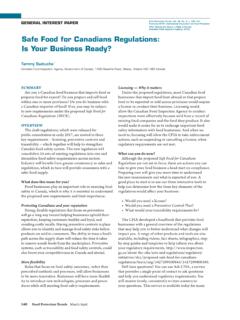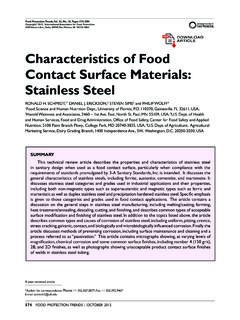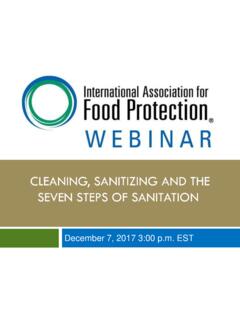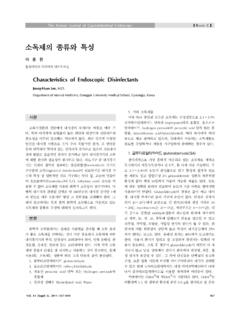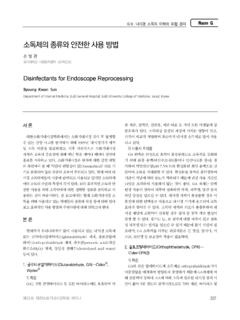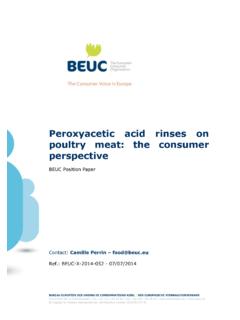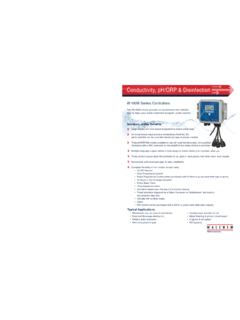Transcription of Peracetic Acid and Hydrogen Peroxide Post-dip …
1 Food Protection Trends March/April96 PEER-REVIEWED ARTICLEFood Protection Trends, Vol 38, No. 2, p. 96 103 Copyright 2018, International Association for Food Protection 6200 Aurora Ave., Suite 200W, Des Moines, IA 50322-2864*Author for correspondence: Telephone: +1 ; E-mail: Acid and Hydrogen Peroxide Post-dip Decay Kinetics on Red Meat and Poultry1 Ecolab, 655 Lone Oak Drive, Eagan, MN 55121, USAR ichard J. Walsh,1* Bruce White,1 Lauren Hunker,1 Oriana Leishman,1 John Hilgren1 and Deborah Klein1 Antimicrobial processing aids are used to mitigate the food safety risk from pathogens that may be present on poultry and beef products. Although efficacy is well documented, post-application decay of the antimicrobial Peracetic acid (and the equilibrium by-product Hydrogen Peroxide ) has not been documented. This was the purpose of the study. Chicken and beef samples were dipped in solutions of > 2000 parts per million (ppm) Peracetic acid for 30 seconds and then set on a drying rack for set time periods.
2 After times ranging from to 30 minutes, samples were assayed for residual Peracetic acid and Hydrogen Peroxide content. The assay consisted of immersing the sample in water and shaking for 30 seconds to recover the residue. The rinse water was then titrated to measure residuals. Exponential decay kinetics were used to predict the time at which < LOD was reached for Peracetic acid and Peroxide on both chicken and beef samples. Because ln(0) is undefined, < LOD was defined as to fit the model. Based on the fitted models, Peracetic acid levels reached < LOD at minutes for chicken, with a 95% confidence interval of ( , ), and minutes for beef, with a 95% confidence interval of ( ,4,0). Hydrogen Peroxide levels reached < LOD at minutes for chicken, with a 95% confidence interval of ( , ), and minutes for beef, with a 95% confidence interval of ( , ). These results support the use of up to 2000 ppm Peracetic acid antimicrobial interventions as processing aids in meat and poultry operations, with no long-term methods for processing of freshly slaughtered poultry or beef rely on use of water in the process for various functions, including cleaning of the inside and outside of the carcass as well as chilling of the carcass to preserve meat quality and retard microbial growth.
3 Recent data for water consumption rates limited to processing operations (not including facility cleaning) is not widely available; however, studies for broiler processors have reported a use range of 21 30 l/bird (all sizes) (7), and a more recent study for beef processors conducted at a ABSTRACT March/April Food Protection Trends97beef processing facility measured 470 l/1000 kg Live Body Weight for intervention processes (14), which is a refinement and reduction from prior reports of 570 1700 l water/animal (2). Although the mechanical action ofwater can provide some removal of surface microbialcontamination that may naturally be present on the carcass,the use of water alone introduces a food safety risk, as asingle carcass may cross-contaminate pathogenic bacteria touncontaminated carcasses being processed at the same timeor later (6).This use of water relates directly to the importance of critical control points in use at processing facilities for organisms of public health significance.
4 To control both pathogenic and spoilage microorganisms naturally present on the meat surface and decrease the presence of microorganisms due to cross-contamination, the use of an antimicrobial agent(s) in process water is common. This method can achieve a reduction in microbial levels by several orders of magnitude. Options available for use in processing include oxidative chemicals, such as hypochlorite, acidified sodium chlorite, bromine, or peroxyacids; organic acids, such as lactic acid; and the quaternary ammonium antiseptic cetylpyridinium chloride (11). Information on the use of each type of antimicrobial is lacking; however, the use of oxidative chlorinated interventions has declined for various reasons. Restrictions on meat or poultry processed with hypochlorite have been in effect since 2010 for Russia, and a ban on the use of pathogen reduction treatments other than water or lactic acid has been in effect for the EU since 1997 (8). Import/Export restrictions are continually revised and subject to change, with the most recent list of approved or disapproved agents permitted for United States exported meat and poultry product use listed in the Department of Agriculture Food Safety and Inspection Service (USDA FSIS) Export Library (13).
5 Of the aforementioned options for microbial intervention, Peracetic acid has almost certainly increased in usage over the past decade. Adoption and acceptance of its use is attributable to several factors, including broad allowance by beef and poultry importing countries, a large operating range with efficacy at low levels, a high tolerance for organic load, and the unique property, by comparison with the others, of a breakdown path resulting in innocuous acetic acid (the acid component of vinegar), water, and oxygen. The use of Peracetic acid thus falls in the category of a processing aid by regulatory definition (12), exhibiting no ongoing technical or functional effect in finished food with the expanded use throughout the industry, recent regulatory updates have approved the use of per-acetic acid at levels ten times higher than that specified in the original approval ( , FDA FCN 1495). Although regulatory authorities agree that Peracetic acid and hydro-gen Peroxide do not persist on meat and poultry, their rate of degradation, which is the focus of the present study, has not been published/studied.
6 The study design was to treat chicken and beef samples at a level of Peracetic acid slightly above the current allowable maximum level of 2000 ppm, drain treated samples for incremental periods of time, and then recover and measure the residual levels of Peracetic acid and Hydrogen Peroxide from the samples, allowing for calculation of decay kinetics of both chemical species. In addition to demonstrating the degradation of both species on either meat type, this study provides a time estimate of the zero-point residue levels for each chemical species ( Peracetic acid or Hydrogen Peroxide ) for each type of meat tested. Such data are frequently used in the evaluation of finished food product safety and meeting certain regulatory authority requirements of negligible residue remaining on product for processing aid AND METHODSF resh, non-frozen chicken drums (with skin and bone) and round steak samples were acquired at a local grocery store and used within 48 hours of purchase. Samples were stored at refrigerated temperatures until used.
7 Chicken drums were used as purchased, beef samples were cut approximately in half, such that each chicken or beef sample tested was in the range of 50 100 g. Commercial Peracetic acid (herein referred to as commercial peracid ) was used for each of the studies, with nominal equilibration levels of Peracetic acid and Hydrogen Peroxide (Ecolab Inc. St. Paul, MN). All dip water used in this study was controlled at 5 grains per gallon hardness. Water was at room temperature (20 22 C) at time of solution preparationPeracetic acid (PAA) dip solution was prepared by adding 10 kg of water to a clean, 20 l plastic pail, into which the commercial peracid was added and thoroughly mixed. The mixed solution was then analyzed using the suppressed Peroxide iodometric method (10) for peracid and Peroxide levels with N thiosulfate titrant. The Peracetic acid and Hydrogen Peroxide levels of the dip/immersion solution was verified before and after all testing to verify that the concentration of Peracetic acid was between 2000 and 2300 ppm.
8 For each test of meat immersion, ~600 ml of a large stock of immersion solution was added to a 1 l beaker, and more was added if needed to fully submerge the chicken or red meat sample. Immersion solutions were used once and discarded, so that the nominal Peracetic acid solution used throughout the study was kept preparation and antimicrobial applicationSamples were manually placed into the Peracetic acid dip solutions and agitated for 30 s, after which time they were aseptically removed with a plastic utensil and set on a rubber-coated metal rack for the set drain times. Whirl-Food Protection Trends March/April98 Pak bags were pre-filled with 205 g of de-ionized water to facilitate sufficient coating of the sample piece during the recovery process, and so that each rinse solution titration sample weighed at least 100 g. Individual meat samples were placed into the bags after set drain times had elapsed. The bags were sealed and manually shaken for 30 40 s, in such a way that the rinse solution completely covered the sample.
9 The bags were then opened, the meat samples were removed and discarded, and the rinse solutions were analyzed for Peracetic acid and Peroxide and analysisBoth types of meat samples were tested in duplicate at each time point, and measurements were repeated on three separate days, for a total of n = 6 samples at each time point. For each meat sample, two separate titrations were performed on the same rinse solution, so that for each time point, 12 data points were obtained. Titrations used the same suppressed Peroxide iodometric method (10), optimized for sensitivity. Briefly, to a clean 250 mL Erlenmeyer flask with a Teflon-coated stir bar, one or two ice cubes were added to maintain Peroxide suppression. The flask was tared on a balance, at least 100 g of the chicken or red meat rinse sample solution was poured into the flask from the Whirl-Pak bag, and the sample weight was recorded. The flask was placed onto a lighted stir plate; 2 4 ml each of glacial acetic acid (Ecolab Supply Chain, peracid grade), starch indicator (Ecolab Cat.)
10 No. 56869), and potassium iodide (10%, Ecolab Cat. No. 56867) were added while stirring. Reagents are added in excess, and exact volumes are not critical, as the measurement relies on the weight of the sample solution added to the flask for Peracetic acid or Peroxide quantitation. A change in the rinse solution color to blue indicated the presence of Peracetic acid. The solution was titrated using N thiosulfate standard (BDH, Cat. No. BDH7256, obtained through VWR Scientific), delivered in 200 L increments (for short drain time samples, when the Peracetic acid or Peroxide levels were high), or 20 L increments using an Eppendorf Multipette, Repeater Plus model (Cat. No. 2687194), fitted with a 1 ml pipette tip. Rapidity in the procedure is accomplished using this titrant addition method, allowing for distinguishable lightening of solution color with lower titrant volume deliveries, thus preventing overshooting of the titration endpoint. A color change from blue to white/clear which held for at least 10 s was considered a completed titration for Peracetic following Peracetic acid titration (or if no blue color was observed after addition of the first reagents), and on the same test solution, 2 4 mls each of 9N sulfuric acid (prepared from 50% stock, Ecolab Supply Chain, peracid grade) and oxygen catalyst ( Molybdate (w/v), Ricca Chemical Company, Cat.
